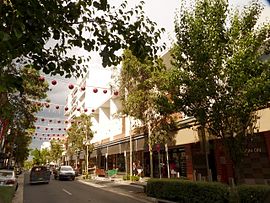Rouse Hill
|
Rouse Hill Sydney, New South Wales |
|||||||||||||
|---|---|---|---|---|---|---|---|---|---|---|---|---|---|

Main Street, Rouse Hill Town Centre shopping centre
|
|||||||||||||
| Population | 7,482 (2011 census) | ||||||||||||
| Established | 1802 | ||||||||||||
| Postcode(s) | 2155 | ||||||||||||
| Location | 42 km (26 mi) north-west of Sydney CBD | ||||||||||||
| LGA(s) | The Hills Shire | ||||||||||||
| State electorate(s) | Castle Hill, Riverstone | ||||||||||||
| Federal Division(s) | Greenway, Mitchell | ||||||||||||
|
|||||||||||||
Rouse Hill is a suburb of Sydney, in the state of New South Wales, Australia. With a population of 7,482 Rouse Hill is located 42 kilometres north-west of the Sydney central business district in the local government area of the City of Blacktown and The Hills Shire. Rouse Hill is part of Greater Western Sydney and is in the Hills District.
Rouse Hill encompasses what was originally known as the Village of Aberdour along with the area originally known as Vinegar Hill following the convict rebellion of 1804. Rouse Hill was serviced by the first ferry service in the colony, the Rose Hill Packet. Vinegar Hill Post Office opened on 1 October 1857 and was renamed Rouse Hill on 13 April 1858. The new name was chosen after the estate of Richard Rouse (1774-1852), a prominent free settler who arrived in the colony in 1801. His first grant here was in 1802 and his second grant was in 1816. Governor Lachlan Macquarie suggested the estate be called Rouse Hill.
Rouse Hill is noteworthy in Australian history as the site of the main battle during an Irish rebellion, known as the Castle Hill rebellion or the second Battle of Vinegar Hill. On 4 March 1804, Irish convicts including political prisoners transported for participating in the Irish Rebellion of 1798, broke out of the Government Farm at Castle Hill, aiming to seize control of the area and to capture Parramatta. The uprising was crushed by the military authorities at Rouse Hill the following day with much loss of life. Many of the participants in the rebellion were summarily executed. The exact site of the Battle is uncertain but a monument with a plaque commemorating the event can be seen within Castlebrook Lawn Cemetery on Windsor Road in Kellyville Ridge.
...
Wikipedia
